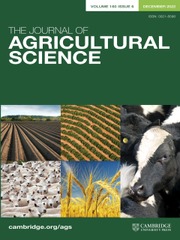Article contents
Crop rotation and sowing date effects on yield of winter wheat
Published online by Cambridge University Press: 08 May 2024
Abstract
Simplified cereal-based crop rotations are widely grown due to economic reasons, leading to the cultivation of wheat after wheat and associated yield losses. In this study, a crop rotation trial was conducted in Northern Germany on a Stagnic Luvisol from 2006 to 2018 with winter wheat after the four most widely used preceding crops in the region (sugar beet, winter wheat, silage maize and winter oilseed rape) in different crop rotations to evaluate potential benefits of different preceding crops. Additionally, the effects of two different sowing dates (2016–2018) and higher crop residue input (whole period) were investigated.
While the pre-preceding crop had no effect, preceding crops winter oilseed rape and sugar beet led to a significantly higher yield of about 1.00 and 0.43 t/ha, respectively, compared to wheat after wheat. This was not modified by crop rotational diversity, including wheat monoculture. Wheat yield tended to be higher for the late sowing date after sugar beet, maize and wheat, while there was no effect of sowing date after oilseed rape. Higher crop residue input led to a significantly higher yield (0.30 t/ha) in wheat after wheat (after pre-preceding crop sugar beet). Overall, sugar beet and winter oilseed rape were found to be favourable preceding crops for winter wheat under the given site conditions. The effect of sowing date on yield and potential modifications of the preceding crop effect by sowing date needs further research in appropriate long-term trials.
- Type
- Crops and Soils Research Paper
- Information
- Copyright
- Copyright © The Author(s), 2024. Published by Cambridge University Press
References
- 1
- Cited by



